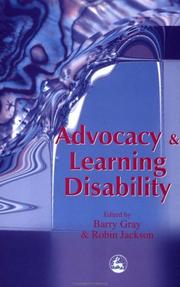| Listing 1 - 5 of 5 |
Sort by
|

ISBN: 128132552X 9786611325527 1846423139 1417502878 9781417502875 9781846423130 1853029424 9781853029424 9781281325525 6611325522 Year: 2002 Publisher: London New York Jessica Kingsley
Abstract | Keywords | Export | Availability | Bookmark
 Loading...
Loading...Choose an application
- Reference Manager
- EndNote
- RefWorks (Direct export to RefWorks)
This book presents an examination of the historical, legal and philosophical contexts within which advocacy services have developed. It discusses the professional and practical issues and problems confronting those running and using advocacy services, the role of advocacy, and advocacy with families and people with communication difficulties.
Learning disabled --- Social advocacy --- Social advocacy. --- Advocacy, Social --- Social service advocacy --- Social work advocacy --- Social service --- LD adults --- Learning disabled adults --- Slow-learning adults --- People with mental disabilities --- Services for. --- Social conditions
Book
ISBN: 1782979956 9781782979951 9781782979968 1782979964 9781782979975 1782979972 9781782979944 1782979948 Year: 2015 Publisher: Oxford Philadelphia
Abstract | Keywords | Export | Availability | Bookmark
 Loading...
Loading...Choose an application
- Reference Manager
- EndNote
- RefWorks (Direct export to RefWorks)
Quarries and quarrying --- Bronze age --- Civilization --- Lithic source areas --- Quarrying --- Rock quarries --- Rock excavation --- Stone industry and trade --- Huntsman's Quarry Site (Kemerton, England) --- England --- Antiquities
Book
ISBN: 1842175858 1842175874 9781842175873 Year: 2011 Publisher: Havertown Oxbow Books
Abstract | Keywords | Export | Availability | Bookmark
 Loading...
Loading...Choose an application
- Reference Manager
- EndNote
- RefWorks (Direct export to RefWorks)
This volume presents the results of the first 10 years of archaeological investigation at Wellington Quarry, Herefordshire. During this time a regionally unique archaeological and palaeoenvironmental sequence was recorded covering nearly 8000 years of interrelated human activity and landscape change in the Lower Lugg Valley. Starting with use by Mesolithic hunter-gatherers, the heavily wooded floodplain witnessed periods of sporadic occupation and activity throughout early prehistory. A mid 4th millennium BC pit group provided a detailed insight into a wide range of seasonally based activities
Quarries and quarrying --- Excavations (Archaeology) --- Neolithic period --- Iron Age --- Wellington Quarry Site (England) --- Lugg Valley (Wales and England) --- Antiquities.
Book

ISBN: 1789250145 1789250129 9781789250121 9781789250145 1789250110 9781789250114 Year: 2018 Publisher: Oxford
Abstract | Keywords | Export | Availability | Bookmark
 Loading...
Loading...Choose an application
- Reference Manager
- EndNote
- RefWorks (Direct export to RefWorks)
Excavations (Archaeology) --- Clifton Quarry (England) --- England --- Antiquities.
Book
ISBN: 1842179357 1842174495 Year: 2012 Publisher: Oxford, England : Oakville, Connecticut : Oxbow Books ; David Brown Book Co.,
Abstract | Keywords | Export | Availability | Bookmark
 Loading...
Loading...Choose an application
- Reference Manager
- EndNote
- RefWorks (Direct export to RefWorks)
The Roman 'small town' of Ariconium in southern Herefordshire has long been known as an important iron production centre but has remained very poorly understood. The town is suggested to have developed from a late Iron Age Dobunnic tribal centre, which owed its evident status and wide range of contacts to control of the production and distribution of Forest of Dean iron. Rapid expansion during the second half of the 1st century AD indicates that the local population was able to articulate rapidly with the economic opportunities the Roman conquest brought. The town developed as a typical small
Romans --- Iron age --- Antiquities. --- Great Britain --- Herefordshire (England) --- History --- Civilization --- Ethnology --- Italic peoples --- Latini (Italic people) --- Herefordshire, Eng. --- Hereford (England : County) --- Herefordshire --- County of Herefordshire (England) --- Hereford and Worcester (England) --- West Midlands (England)
| Listing 1 - 5 of 5 |
Sort by
|

 Search
Search Feedback
Feedback About UniCat
About UniCat  Help
Help News
News